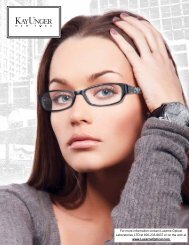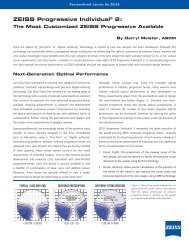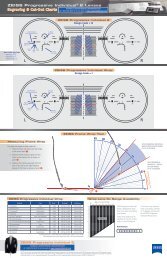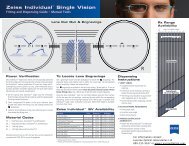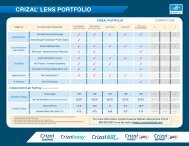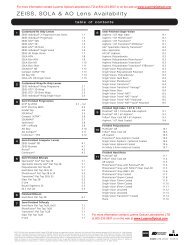Luzerne Optical Laboratories, LTD presents: i.Scription Lenses & i ...
Luzerne Optical Laboratories, LTD presents: i.Scription Lenses & i ...
Luzerne Optical Laboratories, LTD presents: i.Scription Lenses & i ...
You also want an ePaper? Increase the reach of your titles
YUMPU automatically turns print PDFs into web optimized ePapers that Google loves.
<strong>Luzerne</strong> <strong>Optical</strong> <strong>Laboratories</strong>, <strong>LTD</strong> <strong>presents</strong>:i.<strong>Scription</strong> <strong>Lenses</strong> & i.Profiler Measurement System by Zeisstechnology patented by Carl Zeiss Vision.What is i.Profiler plus ®?i.Profiler plus is a sophisticated, full‐featured “3‐in‐1” system that incorporates the industry‐leading ATLAS 9000corneal topographer, wavefront aberrometer, and autorefractor. The i.Profiler plus quickly and easily measures theocular wavefront aberrations and refractive status of the eye as well as the topography and aberrations of thecornea. These measurements can also be presented graphically in an extensive array of contour maps and visionsimulations.What is the purpose of i.Profiler plus ?The i.Profiler plus offers a variety of diagnostic capabilities that are invaluable tools in a variety of clinicalapplications: evaluating the complete refractive status of the eye, including low‐ and high‐order wavefrontaberrations; fitting soft and rigid contact lenses; monitoring ocular disease processes; and managing or comanagingrefractive and surgical interventions. Ocular wavefront data captured by the i.Profiler plus is also used tocalculate an i.<strong>Scription</strong>, which is a wavefront‐guided spectacle correction that offers enhanced visual performanceover a range of viewing conditions.What are wavefront aberrations?Wavefront aberrations represent an increasingly common technique for characterizing the focusing errors of thehuman eye and other optical devices. Wavefront aberrations are generally categorized as either low‐orderaberrations or high‐order aberrations. Low‐order aberrations are associated with the traditional refractive errorsof the eye, or the sphere power and cylinder power of the prescription. High‐order aberrations represent moresubtle focusing errors that can also affect vision quality, particularly at larger pupil sizes. Although it is notpossible to correct the high‐order aberrations of the eye with a spectacle lens, the sphere and cylinder powers ofa traditional prescription can be fine‐tuned to minimize the effects of high‐order aberrations on vision quality.How do high‐order aberrations impact vision?High‐order aberrations create additional image “noise” that degrades vision quality and reduces retinal imagecontrast, particularly at larger pupil sizes. High‐order aberrations can also produce certain glare phenomenaaround lights and other bright objects at night, including “halo” and “starburst” patterns.What technology does the i.Profiler plus use to measure the aberrations of the eye and cornea?The i.Profiler plus measures wavefront aberrations using a Shack‐Hartmann wavefront sensor. It measures thecorneal topography of the eye using a videokeratography system with an integrated Placido disk.Why are the results from the i.Profiler plus superior to those of a conventional autorefractor?Conventional autorefractors can only measure the overall refractive power of the eye, typically over a small,central region of the pupil. They cannot account for local variations in refractive power across the eye due to thepresence of high‐order aberrations. The i.Profiler plus measures the distribution of the refractive power across theFor more information please contact <strong>Luzerne</strong> <strong>Optical</strong> <strong>Laboratories</strong>, <strong>LTD</strong> at 800‐233‐9637or on the web at http://www.<strong>Luzerne</strong><strong>Optical</strong>.com




